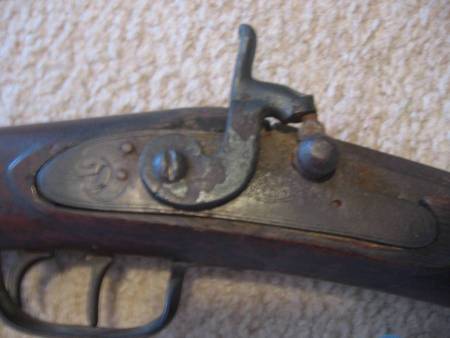|
Thomas May Sr.'s caplock rifle, wooden ramrod with a metal tip, powder horn. The leather pouch contained a flashpan mechanism, two flints, a bullet mold and some lead. According to a great-great grandson, Eldon May, it appears that the rifle was converted from a flintlock to a caplock rifle. As early as the 1820s such a conversion was becaming a common practice to get a more reliable firing mechanism. The flashpan mechanism in the pouch has an 1828 date engraved on it so Thomas probably didn't convert to a caplock rifle until the 1830s or 40s. The next time I have an opportunity, I need to photograph a closer view of the flashpan.
The operator loads the gun, usually from the muzzle end, with black powder followed by shot or a round lead ball, usually wrapped in a paper or cloth patch, all rammed down with a special rod, usually located on the underside of the barrel; A cock or striker tightly holding a shaped bit of flint is rotated to half-cock; The flash pan is primed with a small amount of very finely ground powder, and the flashpan lid is closed; The gun is now in "primed and ready" state, and this is how it would be carried hunting or going into battle. The hammer cannot be dropped from half-cock by just pulling the trigger, but a leather cover is still somtimes placed over the fizzen in case of accidental firing. To fire: The cock or striker is moved from half-cock to full-cock; The gun is aimed and the trigger pulled, releasing the cock or striker holding the flint; The flint strikes the frizzen, a piece of steel on the priming pan lid, opening it and exposing the priming powder; The contact between flint and frizzen produces a spark that is directed into the flashpan; The powder ignites, and the flame passes through a small hole in the barrel (called a vent, or touchhole) that leads to the combustion chamber, igniting the powder there; and The gun discharges.
See details of a Caplock mechanism The percussion cap or primer was the crucial invention needed to make fire-arms that could fire in any weather. Before this development, firearms used igniters with flints or matches to set fire to a pan of gunpowder. The caplock mechanism was the successor of the flintlock mechanism in firearm technology, and used a percussion cap struck by the hammer to set off the main charge, rather than using a piece of flint to strike a steel frizzen. Note: Joshua Shaw - an English born American - is sometimes credited with the development of the first metallic percussion cap in 1814 but his claim remains clouded with controversy as he did not patent the idea until 1822. This invention was gradually improved, and came to be used, first in a steel cap, and then in a copper cap, by various gunmakers and private individuals before coming into general military use nearly thirty years later.
|



